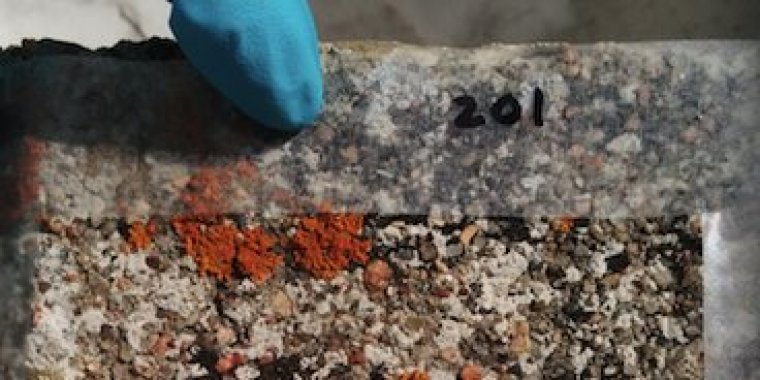| News / Science News |
Tales from the crypt: Life after death in a graveyard
Thought cemeteries were only for the dead? Not so, say scientists Noah Fierer and Tess Brewer of the University of Colorado Boulder. Fierer and Brewer found that graveyards are in fact places of the undead -- in the form of microbes on tombstones.

Close-up of life on the tombstones in Dory Hill Cemetery. Image credit: Tess Brewer
The researchers took samples from the surfaces of 149 gravestones in the Cementerio de Montjuic in Barcelona, Spain; El Queremal Cementario in Valle de Cauca Province, Colombia; Dory Hill Cemetery in Black Hawk, Colorado; and other graveyards.
Several characteristics of each tombstone were recorded, including rock type, length of tombstone exposure (based on date of death), direction of the sampled face (cardinal direction) and surface texture (polished or unpolished).
Scientists have known that microbes are important in the breakdown of rocks into soil, but this study goes a step farther, showing that microorganisms have different 'tastes' for rock type.
They found that rock type is a good predictor of which microbe species grow on tombstones.
For example, microbes that flourish on granite gravestones in Maine are more like those growing on granite gravestones in Belgium than they are to those on limestone tombstones just feet away.
The scientists found that granite tombstones hosted microbes capable of acidifying their environment -- then surviving those acidic conditions.
When exposed to microbially-produced acids, granite tombstones gradually become pitted as bits of rock are dissolved. The pits likely serve as mini-domiciles for microbes, conferring some degree of protection against inhospitable conditions.
Microbes eking out an existence on granite are also more likely to have genes linked with mobility, a trait that allows them to seek out better micro-environments when necessary.
In contrast to the surfaces of granite gravestones, those of limestone tombstones are less acidic. Limestone surfaces are also more likely to harbor lichens -- symbiotic communities composed of fungi and photosynthesizing cyanobacteria or algae.
The results show that gravestones are great places for understanding microbes' survival on rock surfaces and their contributions to rock weathering, the scientists say. (National Science Foundation)
YOU MAY ALSO LIKE





